What Is the Best Companion Plant for Tomatoes: Enhancing Growth and Flavor
- March 20, 2024
- 1 comment
Tomatoes are a staple in gardens worldwide, beloved for their versatility and rich flavor. However, even the most experienced gardeners can face challenges in growing tomatoes. One effective strategy to improve tomato health and yield is companion planting. This article explores the best companion plants for tomatoes, detailing how they can deter pests, improve soil health, and boost tomato growth.

What is Companion Planting?
Companion planting is an age-old gardening practice that involves growing different plants in proximity for mutual benefit. This method has been a part of various indigenous and traditional agricultural systems worldwide. Historically, it’s been used not just for practical benefits but also as a part of cultural rituals and beliefs.
Scientific Basis
The scientific basis for companion planting comes from the understanding that different plants interact with each other and their environment in complex ways. These interactions can be:
- Chemical: Some plants release substances that can either benefit neighboring plants by repelling pests and diseases or improving soil nutrients.
- Physical: Plants can impact each other’s growth patterns due to factors like shading, windbreaks, or root structure.
- Biological: Certain plants attract beneficial insects that can control pests, or they may create a more diverse and healthy ecosystem.
Examples in Action
- Trap Cropping: Some plants, like nasturtiums, can attract pests away from the main crop (tomatoes, in this case).
- Nitrogen Fixation: Leguminous plants (like beans) fix nitrogen from the air, enriching the soil and benefiting neighboring plants like tomatoes.
- Physical Support: Tall plants can provide shade for lower-growing, shade-loving plants. In some cases, plants like climbing beans can use sturdy plants like corn as natural trellises.
Best Companion Plants for Tomatoes
Basil
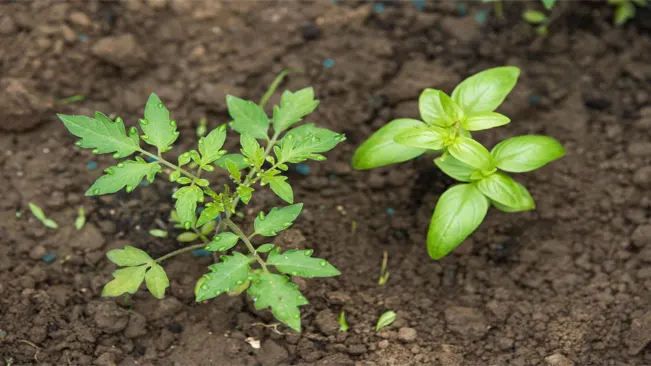
- Flavor Enhancement: Basil is renowned for enhancing the flavor profile of tomatoes, potentially due to shared compounds that complement each other when grown in proximity.
- Pest Repellent: Basil emits a strong scent that naturally repels common garden pests like flies and mosquitoes, providing a protective effect for tomato plants.
Marigolds
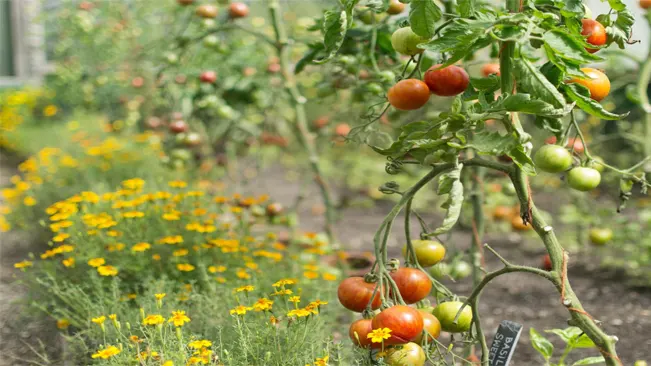
- Nematode Control: Marigolds are particularly effective against root-knot nematodes, which are microscopic worms that can damage tomato roots. They release a chemical into the soil that is toxic to these nematodes.
- Attracting Beneficial Insects: The vibrant flowers of marigolds can also attract pollinators and beneficial insects, which aid in the overall health of the garden.
Carrots
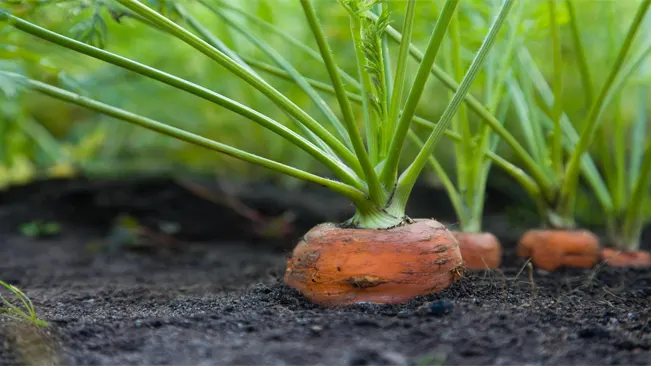
- Soil Aeration: As carrots grow, they push through the soil, creating pathways that improve air and water circulation. This enhanced soil structure benefits tomato roots.
- Mutual Growth Benefits: The deep roots of carrots don’t compete with tomato roots, allowing both to thrive without hindering each other.
Lettuce and Spinach
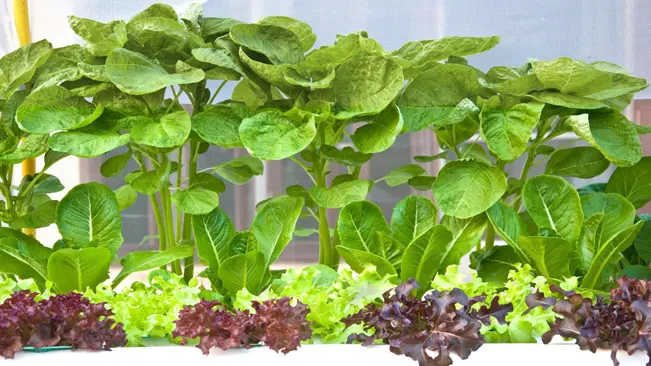
- Shade Utilization: These leafy greens thrive in the partial shade provided by tomato plants, making efficient use of space in the garden.
- Soil Moisture Conservation: The presence of lettuce and spinach helps maintain soil moisture levels, which is beneficial for tomatoes, especially in hotter climates.
Garlic
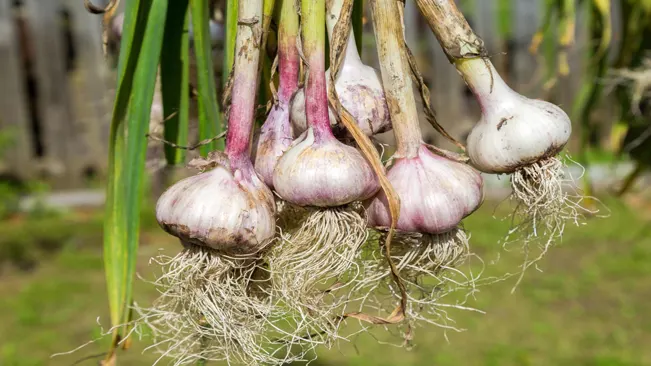
- Spider Mite Repellent: Garlic is a natural deterrent for spider mites, a common pest that can damage tomato plants.
- Flavor Improvement: Some gardeners believe that garlic can subtly influence the flavor of tomatoes, making them tastier.
Borage

- Deterrent for Tomato Hornworms: Borage is particularly effective in repelling tomato hornworms, which can be devastating to tomato plants.
- Growth and Flavor Enhancer: It’s thought that borage can also contribute to the overall growth and flavor enhancement of tomatoes.
Asparagus

- Nematode Repellent: Asparagus helps to control nematodes, similar to marigolds.
- Mutual Pest Protection: Tomatoes offer a benefit in return by repelling asparagus beetles, making this a symbiotic relationship.
Nasturtiums

- Aphid Trap Crop: Nasturtiums serve as a lure for aphids, keeping these pests away from tomato plants.
- Colorful Addition: Their bright blooms add beauty to the garden while performing a functional role in pest management.
Benefits of Companion Planting
Pest Control
Companion planting serves as a natural method for managing pests. Many plants have specific properties that can repel harmful insects or attract beneficial ones, which can be advantageous for tomatoes:
- Herbs like basil and garlic are known to emit strong scents that repel pests like flies, mosquitoes, and spider mites.
- Marigolds, with their distinctive smell, deter nematodes and other soil-dwelling pests harmful to tomatoes.
- Nasturtiums attract aphids away from tomatoes, acting as a sacrificial plant.
Improved Soil Quality
Some companion plants can contribute significantly to the health of the soil:
- Legumes, such as beans and peas, can fix nitrogen in the soil, a nutrient crucial for the growth of tomatoes.
- Deep-rooted plants like carrots can break up the soil, improving its structure and drainage, thus benefiting the root systems of tomato plants.
Increased Biodiversity
Diverse planting can lead to a more resilient and healthy garden ecosystem:
- A variety of plants can attract different beneficial insects like bees, butterflies, and ladybugs, which are essential for pollination and natural pest control.
- Increased plant diversity can also reduce the spread of plant diseases, as many pathogens are plant-specific.
Space Optimization
Companion planting is an efficient way to use garden space:
- Certain plants, when grown together, can complement each other in terms of space usage. For example, tall tomato plants can provide shade for lower-growing, shade-tolerant plants like lettuce or spinach.
- Intercropping, the practice of growing different crops in proximity, can lead to a more efficient use of space, allowing for a greater variety of plants in a limited area.
Considerations and Challenges
Companion planting, particularly with tomatoes, can be a rewarding approach to gardening. However, to reap its benefits, it’s crucial to understand and navigate its complexities. This section delves into the key considerations and challenges associated with companion planting, focusing on spatial arrangement, timing, plant needs, and the influence of local climate and ecology.
Spatial Arrangement
- Understanding Growth Patterns: Each plant has its unique growth habit – some may be sprawling, while others are compact. Understanding these patterns is crucial to prevent overcrowding and to ensure each plant gets adequate space and sunlight.
- Vertical and Horizontal Space Utilization: Companion plants like beans, which grow vertically, can be paired with low-growing plants like lettuce, maximizing garden space efficiently.
- Root System Consideration: Some plants have deep root systems, while others have shallow roots. Companion planting should consider these factors to avoid competition for soil nutrients and space.
Timing
- Synchronized Planting: Companion plants often have different germination and harvesting times. It’s important to synchronize planting to ensure that they grow and benefit each other simultaneously.
- Succession Planting: Rotating companion plants based on their growth cycles can optimize the benefits they provide to tomato plants throughout the growing season.
Plant Needs
- Water Requirements: Companion plants may have varying water needs. Grouping plants with similar watering needs can prevent over or under-watering.
- Nutrient Requirements: Some plants are heavy feeders, while others add nutrients to the soil. Balancing these needs is essential for a harmonious garden.
- Light Requirements: Ensuring that taller plants don’t overshadow shorter plants that require full sun is a key consideration in companion planting.
Local Climate and Ecology
- Climate Adaptation: Plants react differently to various climates. Choosing companion plants that are adapted to your local climate is essential for successful growth.
- Pest and Disease Considerations: Local pests and diseases should influence the choice of companion plants. Some plants might be more effective in certain regions for deterring local pests or diseases.
- Biodiversity and Ecology: Companion planting should aim to enhance local biodiversity. Attracting beneficial insects and promoting a healthy ecosystem is a pivotal aspect of this practice.
Related Post:
- How to Fertilize Tomatoes: Advanced Techniques for First-Time Gardeners
- Learn How to Grow Vegetables in a Greenhouse: Tips And Tricks
- How to Master Tomato Gardening: From Seed to Table
Conclusion
Companion planting is a natural, sustainable way to enhance the health and yield of tomato plants. By choosing the right plant partners, gardeners can enjoy a more bountiful and flavorful tomato harvest. Remember, a diverse garden is not only beneficial for your tomatoes but also for the environment as a whole.
FAQs (Frequently Asked Questions)
- What are companion plants for tomatoes?
Companion plants for tomatoes are plants that, when grown in proximity, can offer various benefits like pest control, improved growth, or enhanced flavor. - Why is basil considered a good companion for tomatoes?
Basil is believed to improve the taste of tomatoes and also repels flies and mosquitoes, making it an ideal companion plant. - How do marigolds benefit tomato plants?
Marigolds repel nematodes and other garden pests that can harm tomato plants. Their bright flowers can also attract beneficial insects. - Can planting carrots with tomatoes improve soil health?
Yes, carrots can help aerate the soil, which improves water and air flow to the roots of tomato plants. - Are there any leafy greens that make good companions for tomatoes?
Lettuce and spinach are great companions as they benefit from the shade provided by tomato plants and help to maintain soil moisture. - What is the benefit of planting garlic near tomato plants?
Garlic can repel spider mites and is believed to improve the flavor of tomatoes. - How does borage benefit tomato plants?
Borage is known to deter tomato hornworms and can also enhance the growth and flavor of tomatoes. - Is asparagus a good companion plant for tomatoes?
Yes, asparagus can repel nematodes harmful to tomatoes, and in return, tomatoes can deter asparagus beetles. - What role do nasturtiums play in companion planting with tomatoes?
Nasturtiums act as a trap crop for aphids, protecting tomatoes from these pests. - Can companion planting eliminate the need for pesticides?
While companion planting can significantly reduce the need for chemical pesticides by controlling pests naturally, it may not completely eliminate the need in all cases.

Kristine Moore
Forestry AuthorI'm Kristine Moore, a seasoned garden landscaping professional with over 30 years of experience. My extensive career has been dedicated to transforming outdoor spaces into stunning, sustainable landscapes. With a deep understanding of horticulture, design principles, and environmental stewardship, I have become a respected figure in the field, known for creating harmonious, visually appealing, and eco-friendly gardens. My commitment to excellence and continuous learning in landscaping trends and techniques has solidified my reputation as an expert in garden design and implementation.











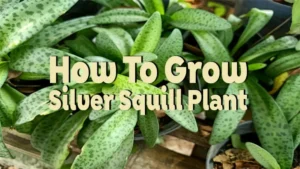

I can't wait to see what else I can do with my vegetable garden. I'm going to keep using companion planting, organic farming, and sustainable agriculture.
Spinach and Tomato Companion Planting: Super Pairs Together!
October 8, 2024 5:15 am